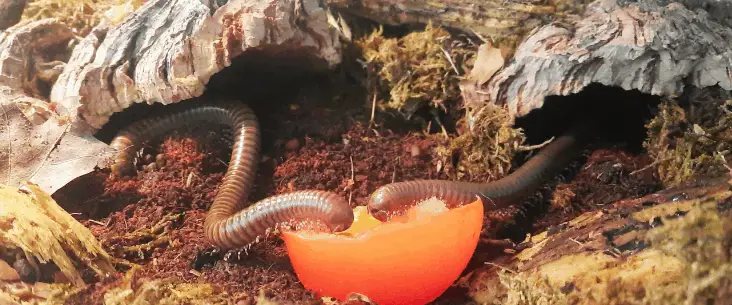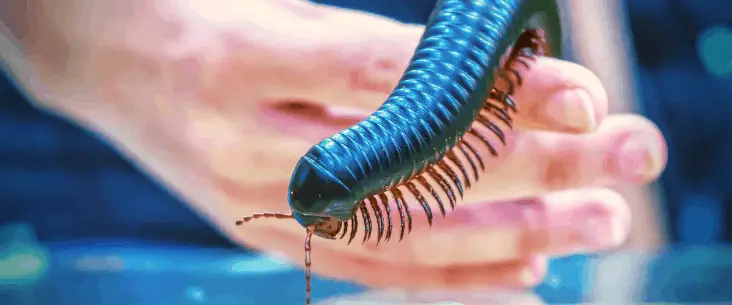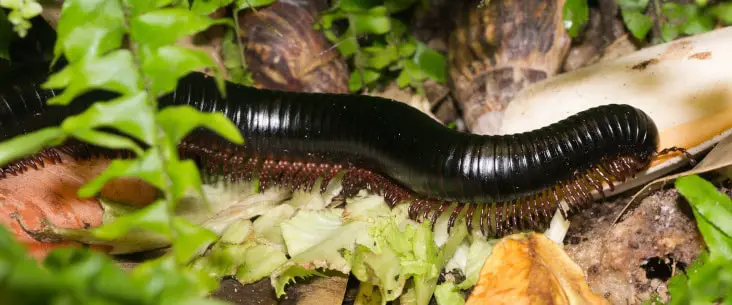Everyone knows millipedes. There are around 12.000 different millipede species in the world known today and they live in almost every corner of the world. They are very popular exotic pet species too. They are often described as long-lived critters. But, how long do they actually live? And where do they come from — or in other words how does the life cycle of millipedes look like. Well, what are you waiting for? Let’s find out!
Female millipedes lay up to 300 eggs in the soil which will hatch within a few weeks. The life cycle exists of 7-8 life cycle stages from egg to become adult. Depending on the species they mature within 1-5 years and millipedes may live for 2-10 years.
Giant millipedes have a long lifespan where some can live up to 10 years (for example the giant African millipede). Amazing right?
The life cycle of millipedes
Most millipedes reproduced sexually, which means the male and female millipede mate before she is able to lay fertile eggs. There are some rare known cases that millipedes can reproduce without mating, called parthenogenesis. However, with most giant millipedes kept as pets, this is not the case and you need both male and female.
The actual breeding can last from 15 minutes to a few hours and can recur after a few days or weeks. The male will grab the female like it is hugging her. He will extend his normally hidden reproducing organ called gonopods. Some males will rhythmically pulse or tap with their legs on the female body.
The life cycle of millipedes exists in three stages: the eggs, the instar and the adult stage.
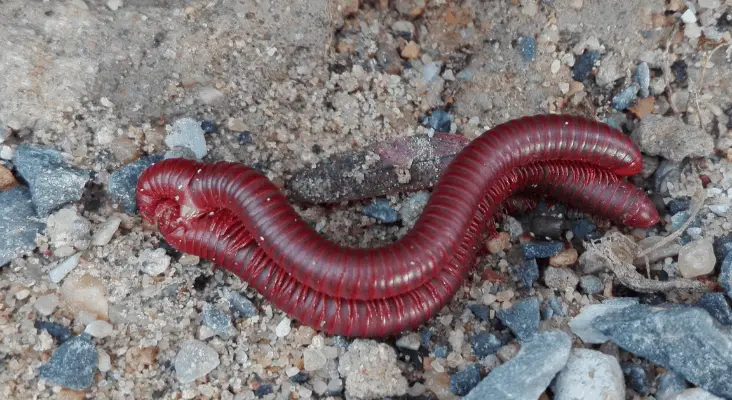
Stage 1: The eggs
After a female has mated she makes herself ready to lay their eggs. She will dig down the substrate to find a quiet place that has the perfect humidity and temperature to incubate the eggs.
Depending on the species, some females will lay eggs randomly into the substrate and others lay clutches of eggs. Some can lay up to 300 eggs in a year, but it will highly vary between different species. Very few millipedes care for their eggs. Most will abandon the eggs and don’t have any parental care.
With most giant millipedes, the eggs are covered with a thin-walled capsule made of chewed soil and wood and are almost impossible to recognize in the soil because they blend in so well. It will lay in the soil for up to three months before the eggs hatch. Eggs are extremely vulnerable and fragile. If the capsule is damaged usually result in the death of the embryo.
Some millipede species lay eggs individually in the substrate without a capsule. The eggs are laid into a fine and damp substrate. The eggs are white transparent coloured and very tiny, and will be deeply burrowed in the substrate. Females will lay one egg a day and keep doing that for a long time, especially when good quality food is available.
Stage 2: Instars
Newly hatched millipedes — called instars — typically have only 3 pairs of legs and one legless segment. With every moult, a couple of segments with legs are added. They are tiny and don’t look like their adults at all (which have between 30 and 350 pairs of legs).
Often the 1st instar is white or grey, and only get some colour after their first moult. They keep on moulting until they reach adult size, which generally can be divided into 6 or 7 stages.
Instars live primarily in the substrate and won’t come above ground for at least the first 3 or 4 instar stages. They feed primarily on the substrate of rotten wood and leaves. When they become older, you may see them walking on the substrate. However, they are still shy and will dig in most of the time.
It takes around 1-5 years for an instar to become an adult, depending on the species. Every species will have its own speed of growth and differs in the number of body segments (and the number of legs).
Related read: Substrate For Millipedes: What You Should Know
Stage 3: Adults
The adult stage is reached after the final moult when they become reproductively mature. It depends on the species how many moults and how long it takes before reaching adulthood. However, some species will continue to moult even after adulthood.
Millipedes can greatly differ in size and their lifespan range from two to ten years, although most giant millipedes are on the higher part of that range. For example, giant African millipedes can become 10 years old when taken good care of, but most giant millipedes have a lifespan of around 5-7 years.
When adulthood is reached, the life cycle is complete and they can mate again for the next generation of millipedes.
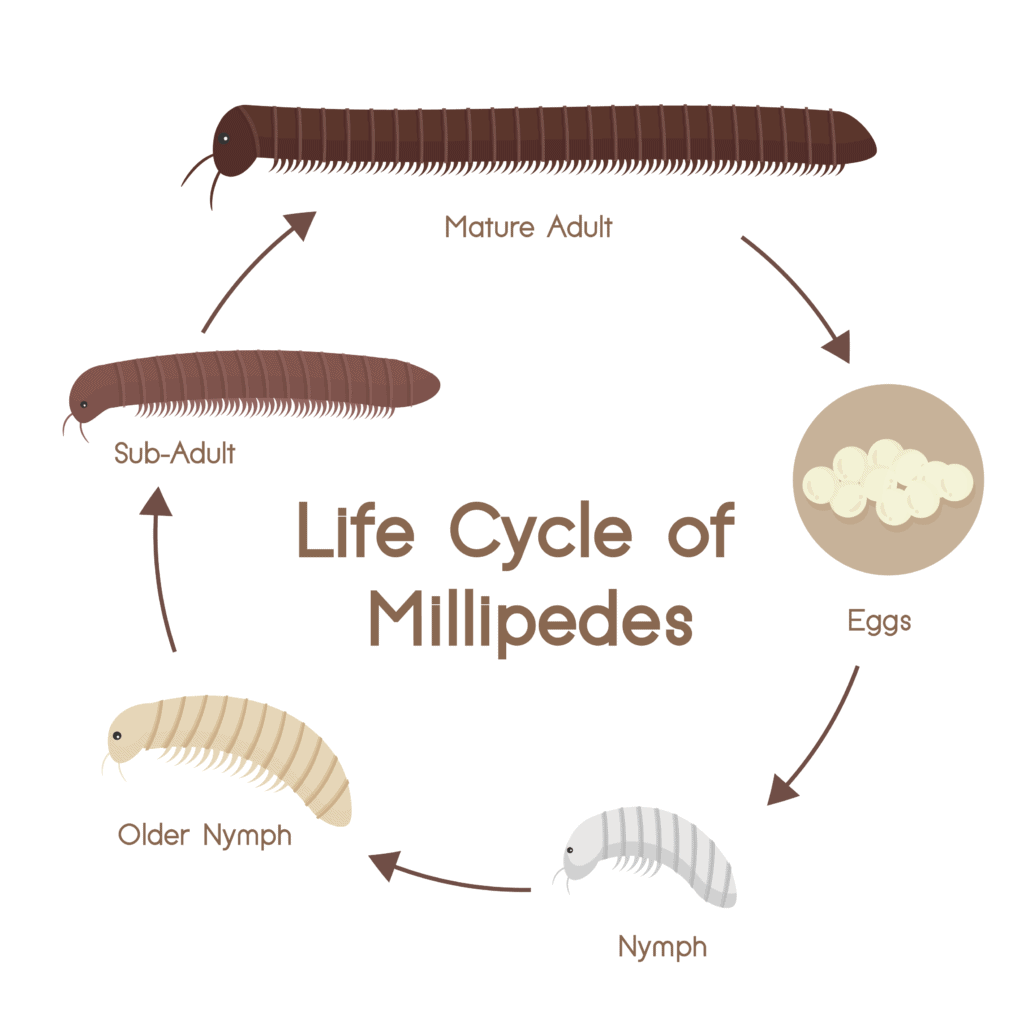
How long do millipedes live in the wild?
With so many different millipede species in the world, their lifespan has a large range. Millipedes can live between one to ten years, although because of predation and different environmental challenges they will not always reach their maximum age.
Generally, the larger millipede species have a greater lifespan and most of the “giant millipedes” will reach an age of at least 5 years. Normally these millipedes become adults halfway in their life.
How long do millipedes live in captivity?
In captivity and laboratory conditions, they can live their full lifespan because of the stable environment and the lack of predators. Without the life challenges and good care, many will easily reach their maximum age. Most giant millipedes that are kept as pets will reach an age of five up to ten years.
However, it is keen to provide a good habitat and provide for their needs so they can thrive throughout all their life stages. Generally, your first pet millipede has already a certain size and therefore is already ‘on age’, so generally they live for another two to six years.
If you fail to provide the optimal habitat, lack a good substrate, or keep them in an enclosure that is too small, your millipede may die quite quickly.
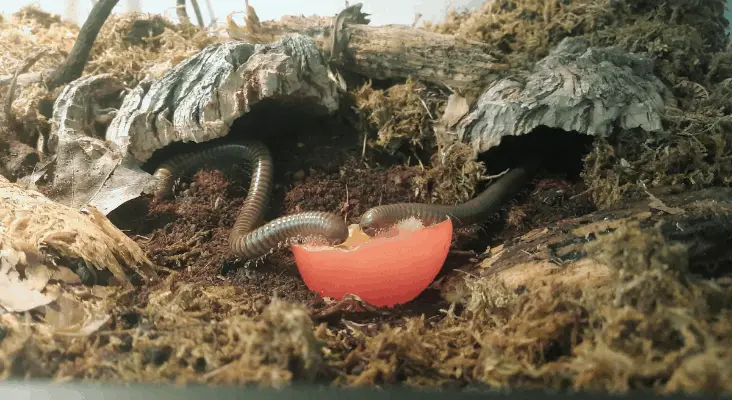
Lifespan and size of different species of pet millipedes
Many different millipede species have many different average lifespans and sizes. In the table below we show you the lifespan and size of most kept millipede species as pets.
| Millipede species | Lifespan | Adult body length |
|---|---|---|
| Bumblebee millipede (Anadenobolus monilicornis) | 2-2,5 years | 5-7.5 cm |
| Mozambique fire millipede (Centrobolus Splendidus) | 2 years | 9 cm |
| Giant African millipede (Archispirostreptus gigas) | 10 years | 28-32 cm |
| Giant African olive millipede (Telodeinopus aoutii) | 5 years | 18 cm |
| Spirostreptus gregorius | 4-5 years | 12 cm |
| Spirostreptus spec. 1 | 5 years | 14 cm |
| Pelmatojulus ligulatus | 4-5 years | 14 cm |
| (Florida) Ivory millipede (Chicobolus spinigerus) | 5-10 years | 10 cm |
| Smokey oak millipede (Narceus gordanus) | 5-10 years | 10 cm |
| American giant millipede (Narceus americanus) | 5-10 years | 10 cm |
| Scarlet millipede (Trigoniulus corallinus) | 4-8 years | 6-8 cm |
| Rainbow millipede (Atopochetus dollfusi) | 5 years | 11 cm |
| Firehead millipede (Spirostreptus servatius) | 5-6 years | 26 cm |
Keep your millipedes healthy and happy
Only when give them the best care will make your millipedes thrive, living their full potential. Only with optimal care they will reach their maximum lifespan and grow big.
We mentioned it already, but the substrate is one of the most important parts of the millipede habitat. It provides food, shelter and helps to keep the environment humid and warm. Without a proper substrate, your millipedes will be very unhappy. When a millipede doesn’t feel comfortable and happy, it will not reach the age it can be.
It is good to research more about keeping and care of millipedes. I encourage you to start reading the article I wrote about the basics of keeping millipedes.
Much more to learn!
There is much more to learn about millipedes. For example, what do millipedes eat? You can find more articles about millipedes with plenty of practical tips to better understand and enjoy the keeping of millipedes as a pet.
Share this page!

